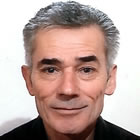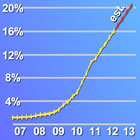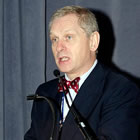 On October 23-25, 2014 the 3rd Advanced International Masterclass on the Transradial Approach will be held in Chicago and, if you already perform or want to start using the wrist approach to diagnostic or interventional procedures, you need to attend. Where else will you be able to spend two-and-a-half days with the most expert and experienced radial practitioners in the world?
On October 23-25, 2014 the 3rd Advanced International Masterclass on the Transradial Approach will be held in Chicago and, if you already perform or want to start using the wrist approach to diagnostic or interventional procedures, you need to attend. Where else will you be able to spend two-and-a-half days with the most expert and experienced radial practitioners in the world?
I went to the very successful AimRADIAL course in New York City last fall and witnessed something I hadn’t really seen since the early days of angioplasty: a relatively small meeting (i.e. less than 300) attended by the pioneers of the procedure, cardiologists who have the largest experience in the radial approach, talking among themselves and trading their latest findings and techniques with each other, and sharing this information with the newer generation of physicians in attendance.It felt like an actual community!
It was a different vibe from massive meetings like TCT or EuroPCR, more personal and, of course, with a very specific agenda: doing procedures from the wrist. It was heartening (yes, a pun found its way into my sentence) to see so many of the physicians who in little more than a decade have changed the procedure of angioplasty worldwide to increase patient safety, comfort and outcomes.

Dr. Ferdinand Kiemeneij
At that meeting the “father of transradial,” Dr. Ferdinand Kiemeneij, attended and gave a wonderful talk on the concept and construction of the “Radial Lounge,” the recovery area for radial patients and their families. The emphasis was on the softer patient-oriented aspects of recovery after a PCI, being with your family, being able to sit or walk immediately afterwards, relaxing and feeling like you’re going to be okay, not that you have this terrible disease and that you’re in a hospital because you’re sick. Is there any way in which supporting these positive feelings in patients post-PCI is not helpful in recovery?
Dr. Kiemeneij will be in attendance at the upcoming meeting, but virtually. He’s going to be doing a live case from Tergooi, The Netherlands. And there will be several live cases, taped demonstrations and a wide spectrum of talks, addressing all aspects of the transradial approach.
So…if you’re thinking of attending AimRADIAL 2014, check out the distinguished faculty, and check out the program agenda.
A word on the faculty. There are a lot of cardiologists from outside the U.S. and that’s a good thing because the radial approach has been used far more extensively OUS than in the States. The U.S. is playing late catch-up.
 When we started the Transradial Access Center on Angioplasty.Org back in 2007, less than 2% of U.S. procedures were performed via the wrist; seven years later the figure is around 20%, a ten-fold increase. During this period there have also been a number of clinical studies and analyses of data, all pointing to the fact that the wrist approach can lead to lower costs, less complications, better 30-day and long-term outcomes and, oh yeah, better patient comfort! Almost every patient who has experienced catheter-based procedures from both the femoral and radial approaches has strongly preferred the radial every time.
When we started the Transradial Access Center on Angioplasty.Org back in 2007, less than 2% of U.S. procedures were performed via the wrist; seven years later the figure is around 20%, a ten-fold increase. During this period there have also been a number of clinical studies and analyses of data, all pointing to the fact that the wrist approach can lead to lower costs, less complications, better 30-day and long-term outcomes and, oh yeah, better patient comfort! Almost every patient who has experienced catheter-based procedures from both the femoral and radial approaches has strongly preferred the radial every time.
And then there’s the hard data. In the current Journal of the American College of Cardiology, a study of 350,000 patients in the UK concludes:
TRA [TransRadial Angioplasty] was independently associated with reduced 30-day mortality, and the magnitude of this effect was related to baseline bleeding risk; those at highest risk of bleeding complications gained the greatest benefit from adoption of TRA during PCI.
As Dr. Jordan Safirstein, Director of Transradial Intervention at Morristown Medical Center in New Jersey, tweeted today about this study. “If there was a drug that conferred this benefit wouldn’t we ALL be using it?” Point taken!

Dr. Olivier Bertrand
Back to the AimRADIAL course, organizer and radial pioneer, Olivier F. Bertrand, MD, PhD, told Angioplasty.Org that “Besides usual themes, special emphasis will be placed this year on 1) peripheral intervention and radial approach, 2) use of dedicated universal catheters versus standard catheters, 3) cost benefits for radial approach in the USA and around the world, including new practice such as same-day discharge, 4) how to use new anticoagulants and new antiplatelets in the lab, 5) radial artery injury and occlusion: prevention and treatment.”
This last point is interesting. Because the radial approach is positioned as a safer alternative to femoral, most radialists are very sensitive to the subject of complications. And, like any medical procedure, there are complications to the transradial approach, but they are small in percentage. However, they do exist and there are several lectures on the program about possible complications, how to avoid them, and what to do about them when they occur.
Finally, the course is not just for doctors. One of the course organizers is Bernadette Speiser, RN. There’s no question that a radial program in a hospital can only be successful when the entire cath lab team is on-board. So emphasis on the nursing, tech and ancillary staff is central to the procedure.
 And, oh yeah, did I mention the gala dinners?
And, oh yeah, did I mention the gala dinners?
Here’s a photo from last year’s NYC course, dinner on a boat that circled NY Harbor, Statue of Liberty, Brooklyn Bridge, etc. The Chicago course will be visiting the famed Art Institute of Chicago on the first night and the Mid-America Club with its 360-degree panoramic view of the city’s distinctive skyline on the second.
More information about AimRADIAL, including CME credits, can be found on the course web site at AIMRADIAL.org. Registration for the course can be found here.



